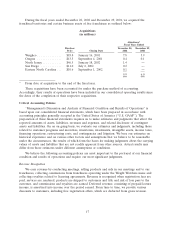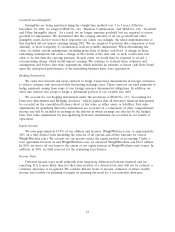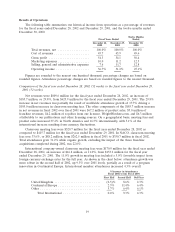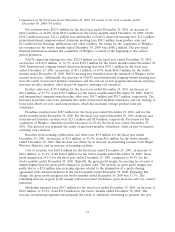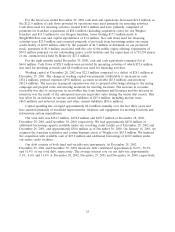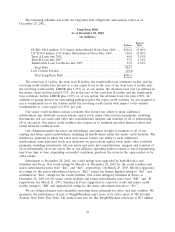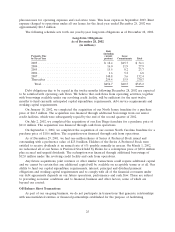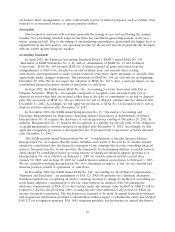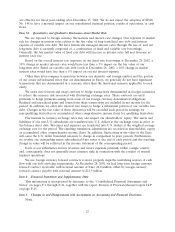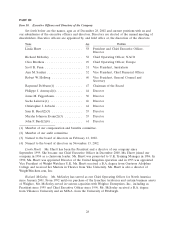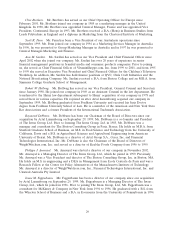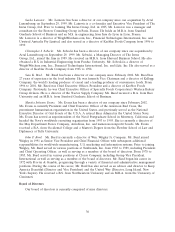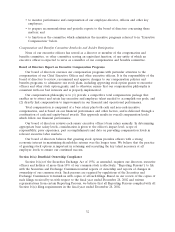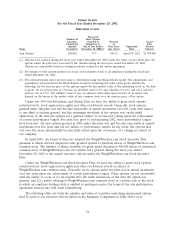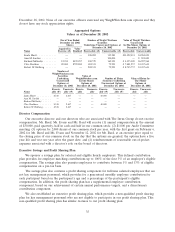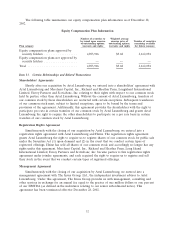WeightWatchers 2002 Annual Report Download - page 34
Download and view the complete annual report
Please find page 34 of the 2002 WeightWatchers annual report below. You can navigate through the pages in the report by either clicking on the pages listed below, or by using the keyword search tool below to find specific information within the annual report.are effective for fiscal years ending after December 15, 2002. We do not expect the adoption of SFAS
No. 148 to have a material impact on our consolidated financial position, results of operations, or cash
flows.
Item 7A. Quantitative and Qualitative Disclosures about Market Risk
We are exposed to foreign currency fluctuations and interest rate changes. Our exposure to market
risk for changes in interest rates relates to the fair value of long-term fixed rate debt and interest
expense of variable rate debt. We have historically managed interest rates through the use of, and our
long-term debt is currently composed of, a combination of fixed and variable rate borrowings.
Generally, the fair market value of fixed rate debt will increase as interest rates fall and decrease as
interest rates rise.
Based on the overall interest rate exposure on our fixed rate borrowings at December 28, 2002, a
10% change in market interest rates would have less than a 5% impact on the fair value of our
long-term debt. Based on variable rate debt levels at December 28, 2002, a 10% change in market
interest rates would have less than a 5% impact on our net interest expense.
Other than inter-company transactions between our domestic and foreign entities and the portion
of our senior subordinated notes that are denominated in Euros, we generally do not have significant
transactions that are denominated in a currency other than the functional currency applicable to each
entity.
We enter into forward and swap contracts to hedge transactions denominated in foreign currencies
to reduce the currency risk associated with fluctuating exchange rates. These contracts are used
primarily to hedge payments arising from some of our foreign currency denominated obligations.
Realized and unrealized gains and losses from these transactions are included in net income for the
period. In addition, we enter into interest rate swaps to hedge a substantial portion of our variable rate
debt. Changes in the fair value of these derivatives will be recorded each period in earnings for
non-qualifying derivatives or accumulated other comprehensive income (loss) for qualifying derivatives.
Fluctuations in currency exchange rates may also impact our shareholders’ equity. The assets and
liabilities of our non-U.S. subsidiaries are translated into U.S. dollars at the exchange rates in effect at
the balance sheet date. Revenues and expenses are translated into U.S. dollars at the weighted average
exchange rate for the period. The resulting translation adjustments are recorded in shareholders’ equity
as accumulated other comprehensive income (loss). In addition, fluctuations in the value of the Euro
will cause the U.S. dollar translated amounts to change in comparison to prior periods. Furthermore,
we revalue our outstanding senior subordinated Euro notes at the end of each period and the resulting
change in value will be reflected in the income statement of the corresponding period.
Each of our subsidiaries derives revenues and incurs expenses primarily within a single country
and, consequently, does not generally incur currency risks in connection with the conduct of normal
business operations.
We use foreign currency forward contracts to more properly align the underlying sources of cash
flow with our debt servicing requirements. At December 28, 2002, we had long-term foreign currency
forward contract receivable with notional amount of Euro 24.0 million, offset by foreign currency
forward contract payable with notional amount of $21.9 million.
Item 8. Financial Statements and Supplementary Data
This information is incorporated by reference to the ‘‘Consolidated Financial Statements and
Notes’’ on pages F-1 through F-44, together with the report thereon of PricewaterhouseCoopers LLP
on page F-45.
Item 9. Changes in and Disagreements with Accountants on Accounting and Financial Disclosure
None.
27


